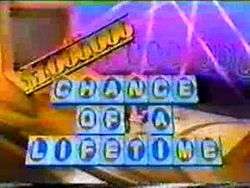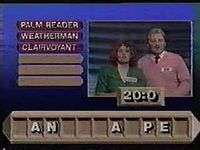The $1,000,000 Chance of a Lifetime
The $1,000,000 Chance of a Lifetime is an American game show which offered a $1 million (annuitized) grand prize to winning contestants. The show aired in syndication from January 6, 1986, until September 11, 1987. The show was hosted by Jim Lange, and he was joined by Karen Thomas as co-host during the second season. Marc Summers was the show's announcer for its first few weeks and Johnny Gilbert announced the remainder of the series. The show was produced by XPTLA, Inc., and distributed by Lorimar-Telepictures.
| The $1,000,000 Chance of a Lifetime | |
|---|---|
 | |
| Genre | Game show |
| Directed by | Jerome Shaw Joe Carolei |
| Presented by | Jim Lange |
| Narrated by | Marc Summers (1986) Johnny Gilbert (1986–1987) |
| Country of origin | |
| No. of seasons | 2 |
| Production | |
| Executive producer(s) | Bob Synes Scott A. Stone Jay Feldman |
| Producer(s) | Joel Stein |
| Production location(s) | Hollywood Center Studios Hollywood, California |
| Running time | approx. 22–26 minutes |
| Production company(s) | XPTLA Company Lorimar-Telepictures |
| Distributor | Lorimar-Telepictures |
| Release | |
| Original network | Syndicated (daily) |
| Original release | January 6, 1986 – September 11, 1987 |
| Chronology | |
| Related shows | All Clued Up (UK version) |
Gameplay
Two couples competed each day, one of which was usually a returning champion. The two couples tried to win money by solving hangman-style word puzzles.
In order to fill-in the blank spaces in the puzzle, a series of toss-up clues were played. The clues were usually one word in length, but certain clues called for two or even three words to be used. The contestants were told how many letters were in the clue and the letters were put into the clue one at a time until one of the contestants buzzed in. If that contestant gave a correct answer, the couple scored $25. If not, the clue would be filled in up to the last letter and the opposing contestant got the chance to guess.
Once a contestant guessed correctly, he/she stepped up to an oversized keyboard to place letters in the puzzle, which was displayed on a giant screen. All of the letters appearing in the puzzle, as well as a star if there were any punctuation marks in it, were lit on the keyboard. There was always an additional key lit that represented a letter or symbol that did not appear in the puzzle; the decoy key was referred to as "The Stinger". Correctly guessing the clues earned the contestants the choice of two letters on the keyboard, and each time the letter appeared in the puzzle $25 was added to a bank that went to the couple who solved the puzzle. If either contestant found the Stinger, their turn immediately ended and a new clue was played.
In the second round, the couples switched positions and the values for each word and correctly placed letter doubled to $50. For the third round, as well as any subsequent rounds, the values rose to $100 and each couple had to choose which one of them would play. The game continued as long as time permitted. If time ran short during a puzzle, each of the remaining letters was put into the puzzle one at a time and the bank continued to accumulate until one of the couples answered correctly.
The couple in the lead at the end of the game won their bank and played the bonus round. If there was a tie after the final puzzle, a final toss-up clue was played with sudden death rules; a correct answer won the game, but an incorrect answer resulted in an automatic loss.
Losing couples received parting gifts, a copy of the show's home game, and their front game winnings if they were an outgoing champion.
Bonus round

In the bonus round, the couple had to solve six words or phrases within 60 seconds. Before the round, they were presented with three categories to choose from. Once they made the selection, the show's on-stage security guard led them into an isolation booth which was wired so they could only hear Lange and could only see the game board screen.
The round began on Lange's command and one letter at a time was placed in the word/phrase. Letters were revealed at a rate of approximately one per 1.5 seconds, and the couple simply kept guessing until coming up with a right answer. The process continued until the couple either got all six correct answers to win the round or the sixty second time limit expired.
If the couple successfully completed the bonus round in their first attempt, they were offered $5,000 and a choice to retire as undefeated champions or to return the next day and face another couple on the following show. If the couple chose to return and then completed the bonus round a second time, the offer increased to $10,000.
If the couple advanced to the bonus round for a third day, they played for the $1,000,000 top prize. In the first season, the grand prize was an annuity, with the couple receiving $40,000 a year for 25 years. For the second season, the couple received over $900,000 as an annuity and an additional $100,000 in prizes, including a pair of automobiles and 20 round-trip tickets on Delta Air Lines valid for any destination in the continental United States.
If at any time the couple failed to win the bonus round, they were retired as champions and left with whatever they had won in the main game to that point.
During its two-season run, a total of nine couples won the grand prize.[1]
Merchandise
A single board game based on the show was released by Cardinal in 1986.
International versions
| Country | Local Name | Host | Channel | Year Aired |
|---|---|---|---|---|
| El Programa del Millón | Fernando González Pacheco | Cadena Dos | 1986–90 | |
| All Clued Up | David Hamilton | ITV | 1988–91 | |
| Domingo Milionário | J.Silvestre | Rede Manchete | 1997–99 |
References
- David Schwartz, Steve Ryan & Fred Wostbrock, The Encyclopedia of TV Game $hows, Checkmark Books, 1999, pp. 161